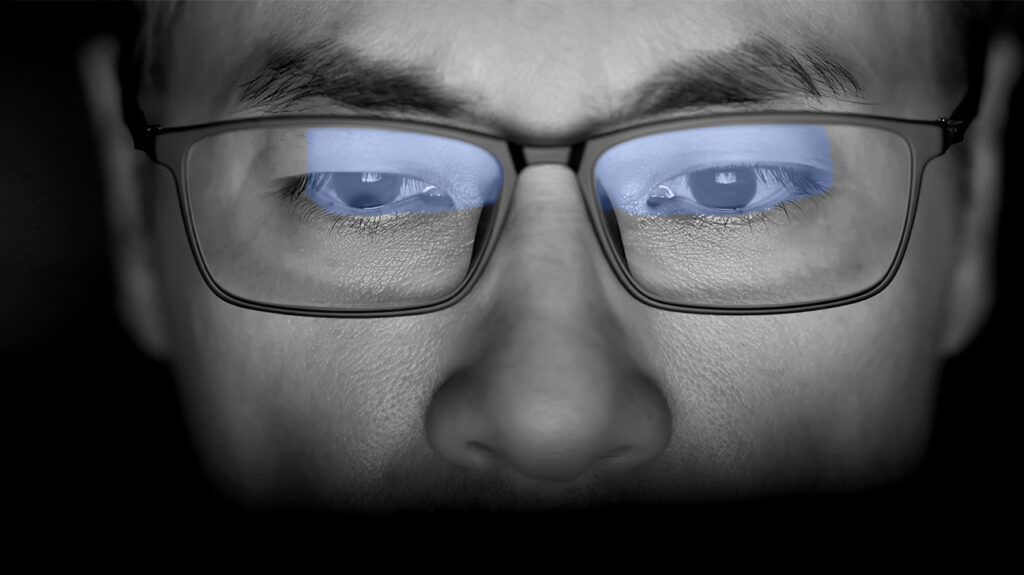Using devices with screens, such as computers, smartphones, and tablets, may lead to dry eye. To prevent it, people can take regular screen breaks and make adjustments to their environment.
Around
Spending prolonged periods looking at a screen may contribute to dry eye in several ways, as this article explains.

Ways that screen time may contribute to dry eyes include:
Reduced blinking rate
One reason screen use may contribute to dry eye is a marked reduction in a person’s blinking rate. Blinking is essential for spreading the tear film evenly across the eyes’ surface, keeping them lubricated.
Studies have shown that a person’s blink rate can decrease by as much as
Screen position
Often, people position screens in a way that causes the eyes to open wider to see the entire screen, which can increase tear evaporation.
Dry air
Many people use screens in air-conditioned or heated environments, which can dry out the air and the eyes. Extended periods of screen time without breaks increase the eyes’ exposure to conditions that promote dryness. Constant exposure to air can increase tear evaporation.
Blue light exposure
While experts have yet to establish a direct connection between blue light exposure from screens and dry eye, it is possible that blue light contributes to eyestrain and discomfort. This may worsen dry eye symptoms.
Preventing dry eye caused by screen use involves adopting habits and making environmental adjustments that help maintain eye moisture and reduce eyestrain.
Follow the 20-20-20 rule
Every 20 minutes, take a 20-second break to look at something at least 20 feet away. This short break can help reduce eyestrain and encourage blinking, which refreshes the eye’s surface.
Read more about the 20-20-20 rule.
Ensure proper blinking
Make a conscious effort to blink fully and frequently. Blinking spreads the tear film evenly across the eye, which prevents dryness. People can consider blinking exercises if they find themselves forgetting to blink.
Adjust screen position
Position the computer screen about an arm’s length away, with the top of the screen at or slightly below eye level. This positioning helps reduce eyestrain and decreases the eyes’ exposure to air, which can evaporate tears.
Use proper lighting
Avoid overly bright lighting or direct glare on the computer screen. Use blinds or shades on windows and an adjustable desk lamp to ensure that lighting is not causing glare or straining the eyes.
Minimize air movement
Direct airflow from fans, air conditioners, or heaters away from the face. Moving air can increase tear evaporation,
Adjust computer settings
Increase text size and contrast and reduce screen brightness to make reading easier on the eyes. Consider using a blue light filter, especially during the evening, to reduce potential eyestrain from blue light exposure.
Use humidifiers
Adding moisture to the air with a humidifier can help
Stay hydrated
Drink plenty of water throughout the day. Good hydration contributes to maintaining sufficient tear volume, which is essential for eye health.
Take regular breaks
Beyond the 20-20-20 rule, people should take longer breaks to rest their eyes. Stand up, stretch, and walk around to reduce overall strain and allow the eyes to recover.
Treating dry eye caused by computer use involves a combination of home remedies, lifestyle adjustments, and possibly medical treatment for severe symptoms.
- Artificial tears: Over-the-counter artificial tear drops can provide immediate relief by lubricating the eyes. People who apply them more than four times per day should use preservative-free drops.
- Prescription eye drops: For more severe dry eye, a doctor may prescribe eye drops that help increase tear production or anti-inflammatory drops to reduce eyelid inflammation contributing to dry eye symptoms.
- Punctal plugs: In cases where tears drain too quickly from the eyes, an eye doctor might suggest punctal plugs. A doctor inserts these small devices into the tear ducts to slow the drainage of tears, helping keep the eyes more lubricated.
- Eyelid hygiene: If dry eye is associated with blepharitis or meibomian gland dysfunction, practicing good eyelid hygiene can help. Warm compresses and gentle eyelid scrubs can reduce inflammation and improve the quality of oils in the tear film.
If dry eye symptoms persist despite adjustments to screen use or if they significantly affect a person’s quality of life, they should consult an eye care professional.
Medical professionals can provide a comprehensive evaluation and recommend a personalized treatment plan. Early intervention and a combination of treatments tailored to a person’s needs are key to effectively managing dry eye symptoms.
Regular screen use can contribute to dry eyes by decreasing how often people blink and increasing tear evaporation. Environments with dry air also play a role.
To prevent dry eyes, people can take regular screen breaks, adjust their computer equipment and lighting, and use a humidifier to moisten the air.
To treat dry eyes, people may wish to use artificial tears or a warm compress to increase eye lubrication.
Eye health resources
Visit our dedicated hub for more research-backed information and in-depth resources on eye health.
